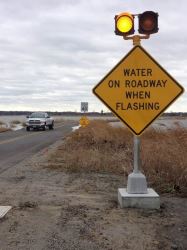The Town of Slaughter Beach, like other low-lying Delaware Bayfront communities, is vulnerable to natural hazards from multiple sources.
Slaughter Beach currently experiences frequent flooding of streets and property during high tide. The town is also at risk for less frequent, but more extreme flooding events from storm surges during nor’easters and tropical storms. In addition, due to rising sea levels, a larger area of the community will be inundated by high tides and there will be more frequent and intense flood events in the future.
Climate change will also influence the temperatures and precipitation rates throughout the year, increasing the risks to the community of heat exposure and drought.
Starting in the spring of 2016, the Delaware Department of Natural Resources and Environmental Control’s Delaware Coastal Programs (DCP) office began working with the Town to carry out a comprehensive assessment of risks to the community from coastal storms, sea level rise and extreme tides. Potential risks, from wildfires and temperature changes due to climate change were also examined.
This assessment informed the Town’s development of adaptation and mitigation measures to enhance the Town’s resiliency, or ability to withstand and bounce back from natural hazards.
Public participation has been extremely important to this effort. Through public engagement in several workshops, focus groups, and community-wide surveys, full and part time residents and stakeholders had the opportunity to contribute input and brainstorm strategies for addressing these risks. This work in this partnership will also be promoted through information sharing across the state and region so that other municipalities and communities may benefit.
The process of developing a more resilient community in the Town of Slaughter Beach involved an assessment of the Town’s current vulnerability to natural hazards and how climate related issues may impact the community in the future. Following this inventory, identification of adaptation and implementation strategies were developed. Public participation was encouraged throughout the process. Through a community wide survey, focus groups, and three public workshops, residents and stakeholders had the opportunity to contribute input and brainstorm strategies that address and prepare for risks.
The project has produced a Coastal Vulnerability Assessment and Adaptation Options Report for Slaughter Beach. The report includes information about the town and its vulnerabilities, details about the public process and discussions, and recommended actions.

Real-Time Transportation Warning System – Integrate into the state’s real-time transportation monitoring system so that residents and visitors are alerted of flooding.
Signage placed on Cedar Beach and Slaughter Beach Roads will alert drivers of flooding in real time. This warning system will improve public safety and give residents up to date information for route planning.
With the incorporation of Slaughter Beach Road and Cedar Beach Road into the state’s real time transportation system, residents and visitors can check the DelDOT smartphone app to be alerted to any flood conditions on the roadways. This collaboration with DelDot also includes the using the 1380AM radio station to hear news updates of flooding of road conditions.
Community Preparedness Education and Outreach – Promote outreach and education on emergency preparedness and resiliency to hazards such as flooding and extreme heat. Schedule an annual Community Preparedness Day.
Secure Utility Tanks to the Ground – Promote public safety by working with homeowners and utility companies to secure propane tanks and other utility tanks to the ground.
Beach Nourishment – Invest in small-scale beach nourishment projects to address critically eroded locations. Continue dialogue with federal and state partners regarding large-scale beach
nourishment and the beneficial reuse of dredge spoils. Explore alternate revenue sources of Town match for beach nourishment.
Community Wide Emergency Plan – Coordinate with County, DEMA, and Fire Company; Form community workgroup to update and refine emergency planning content on the Town website.
Elevate Homes and Utilities – Raise a/c units, generators, and the lower level of existing and new houses and structures above FEMA’s base flood elevation by an additional 18 inches or more.
July 22, 2017 Resilient Community Day Public Workshop
October 8, 2016 Town of Slaughter Beach Public Workshop
June 3, 2016 Town of Slaughter Beach Public Open House
Couldn’t attend an event? Please send your comments on the project to this email: DNREC_DCP_PublicComment@delaware.gov
Related Topics: coastal, community, education, land-use, management, ocean and coasts, planning, resilience, resilient communities, slaughter beach, training